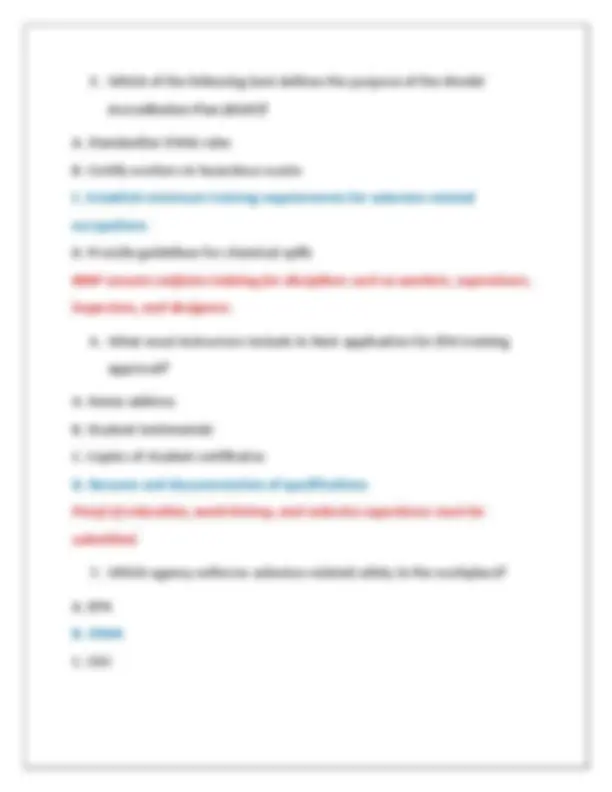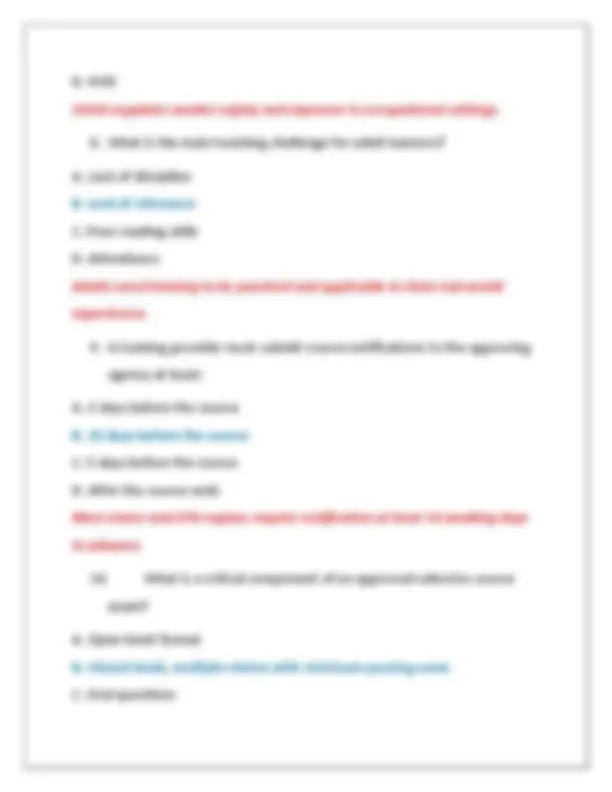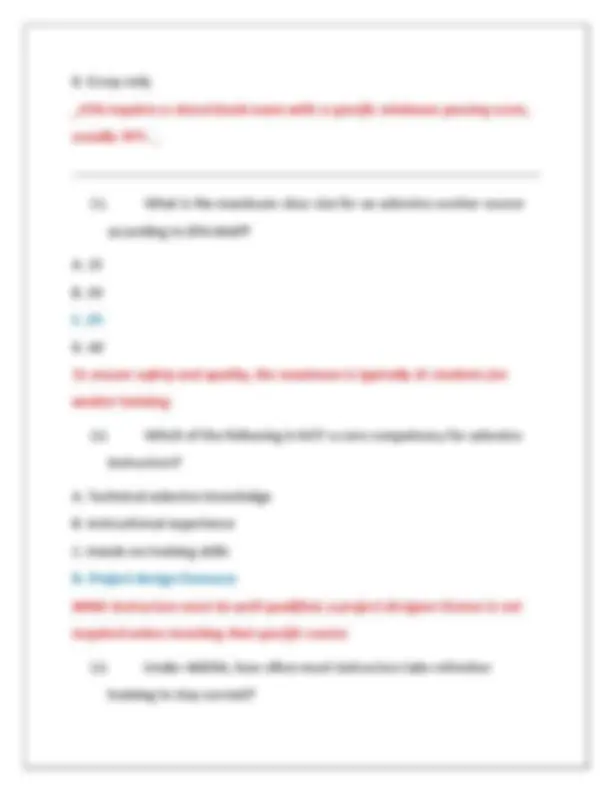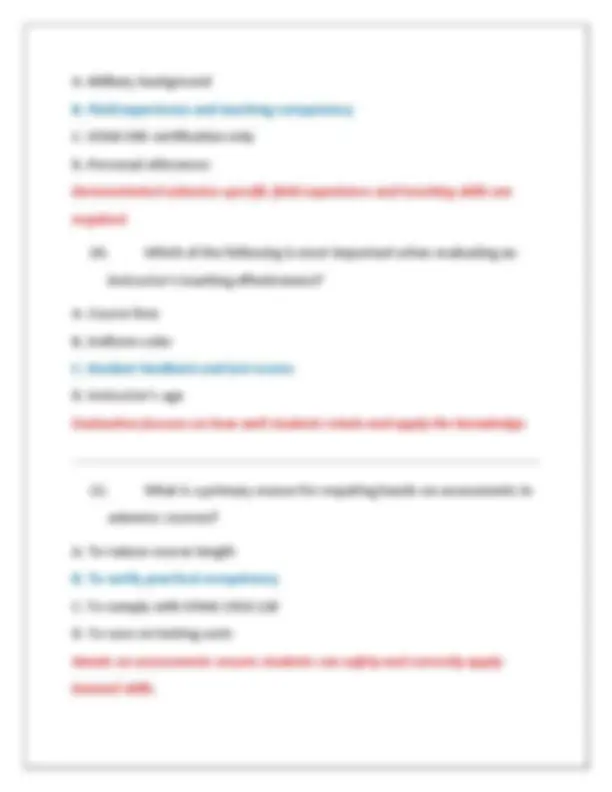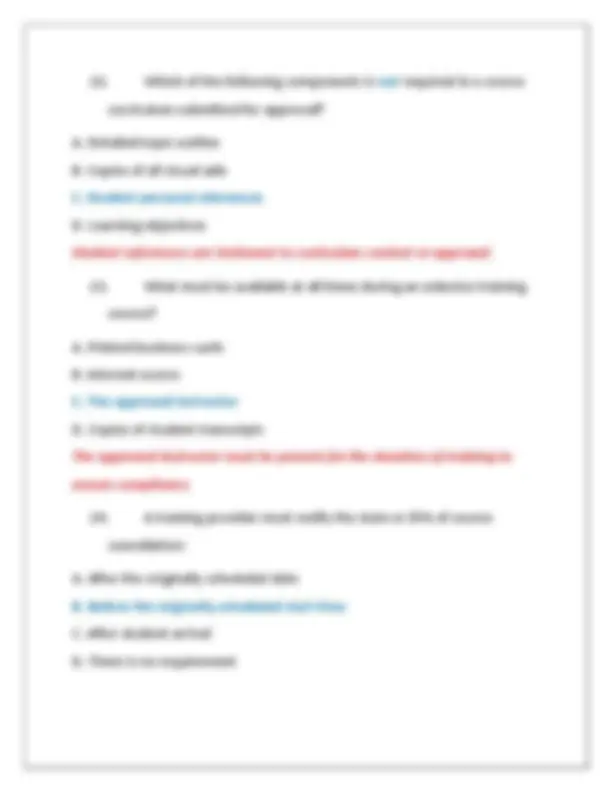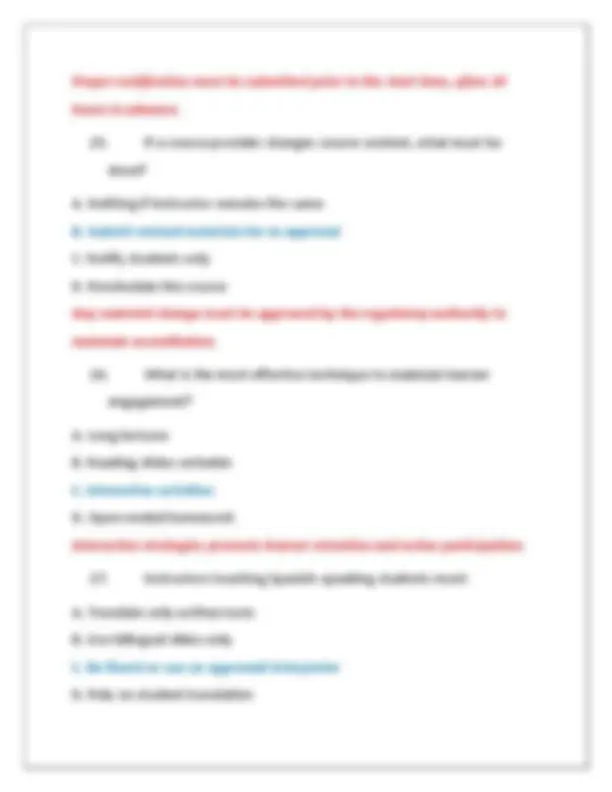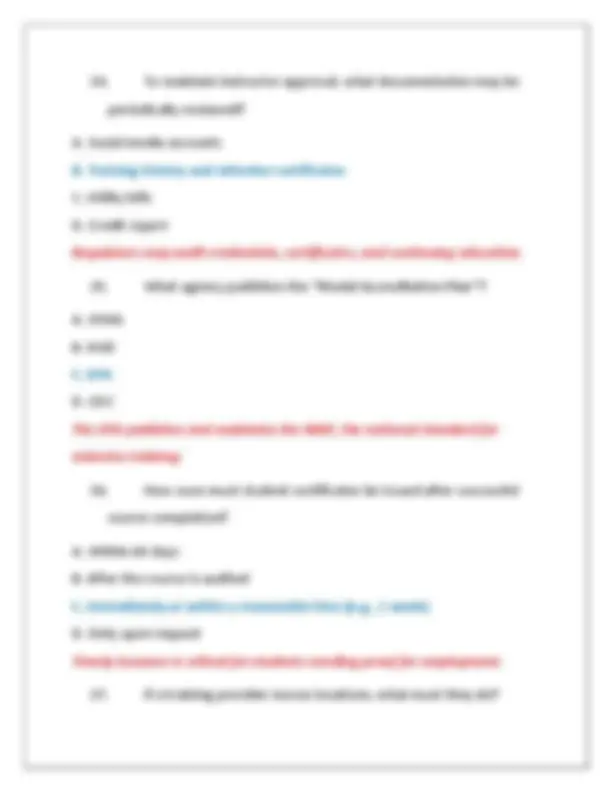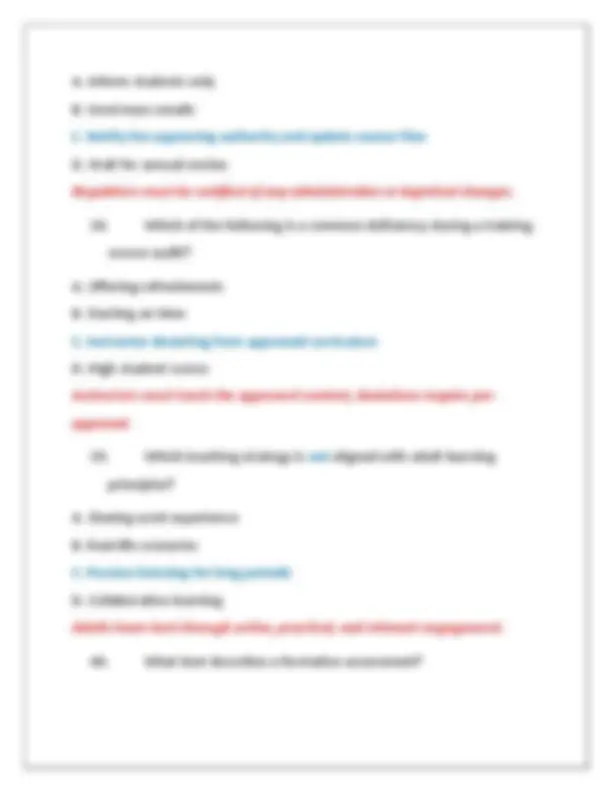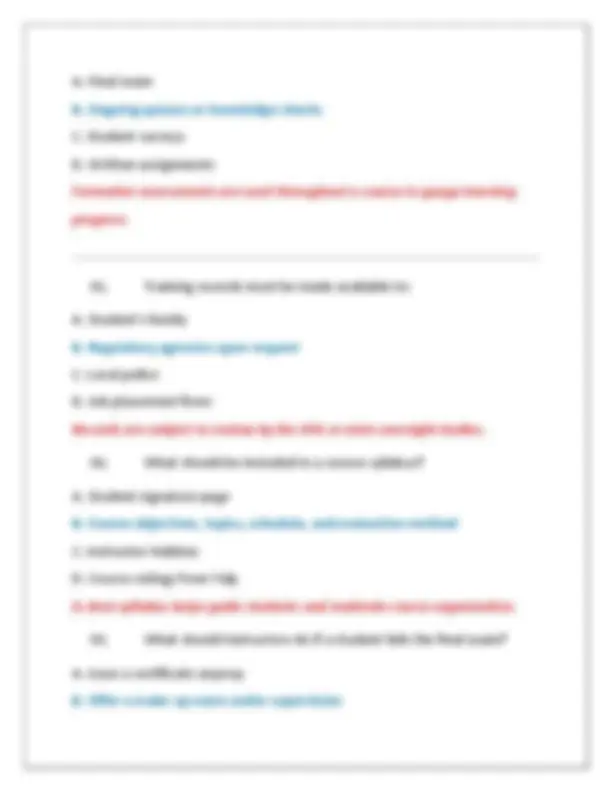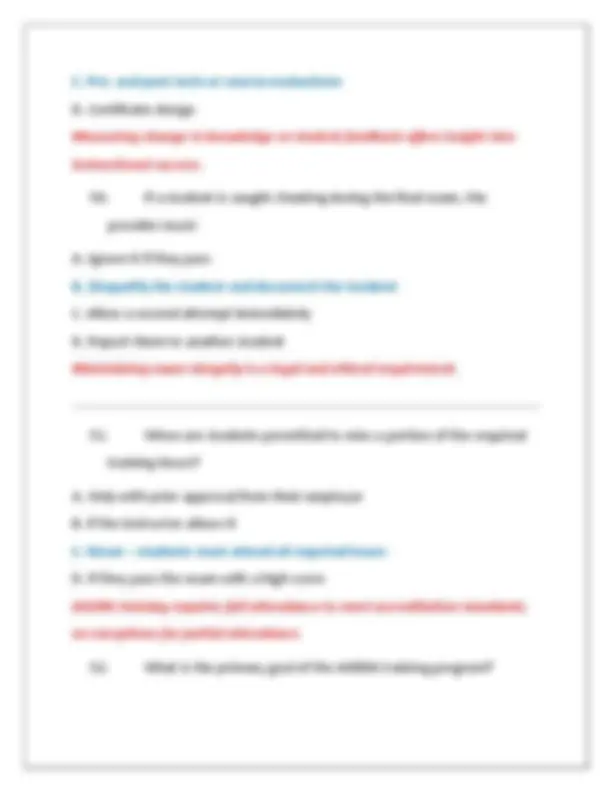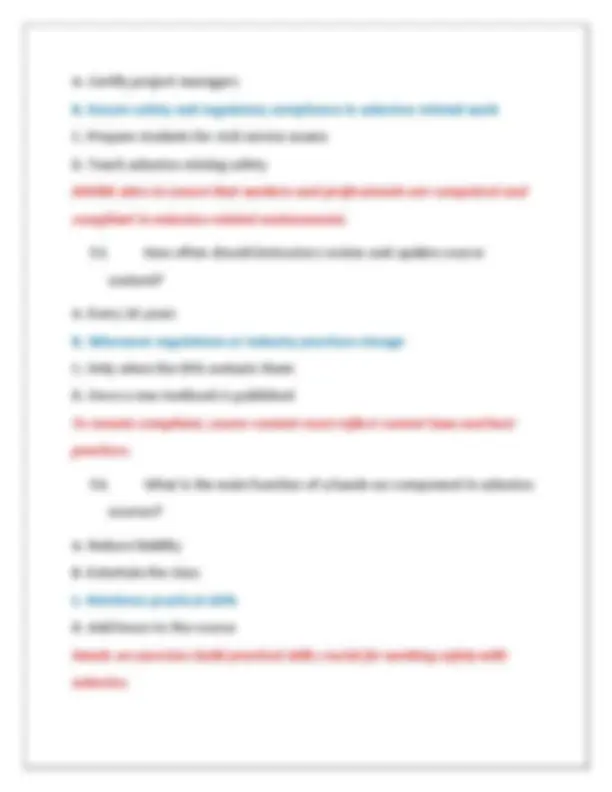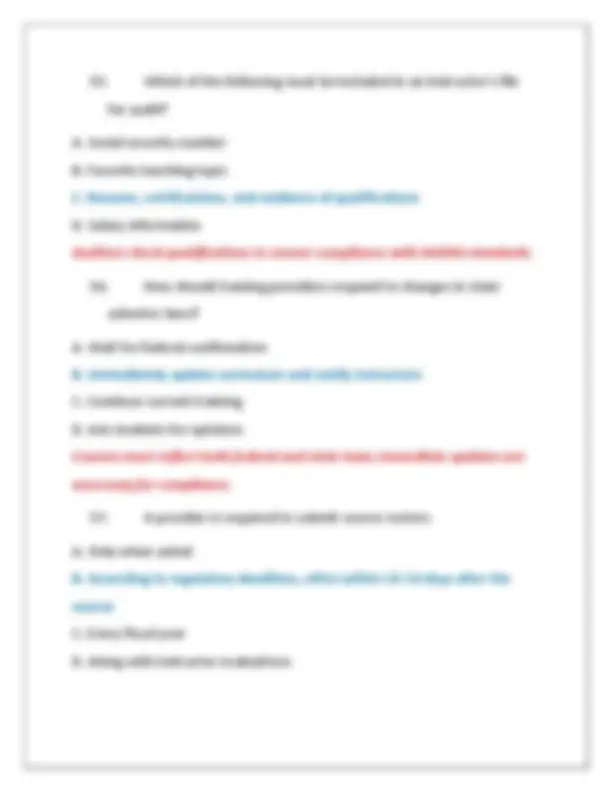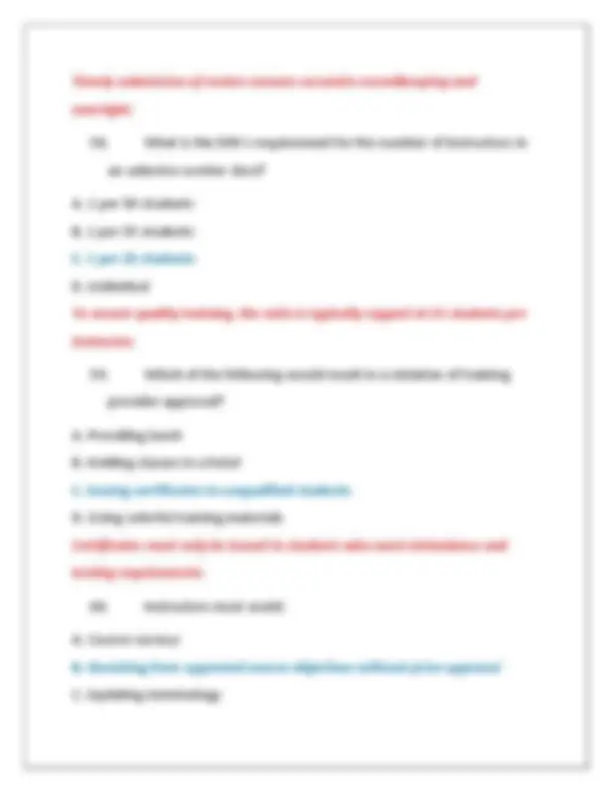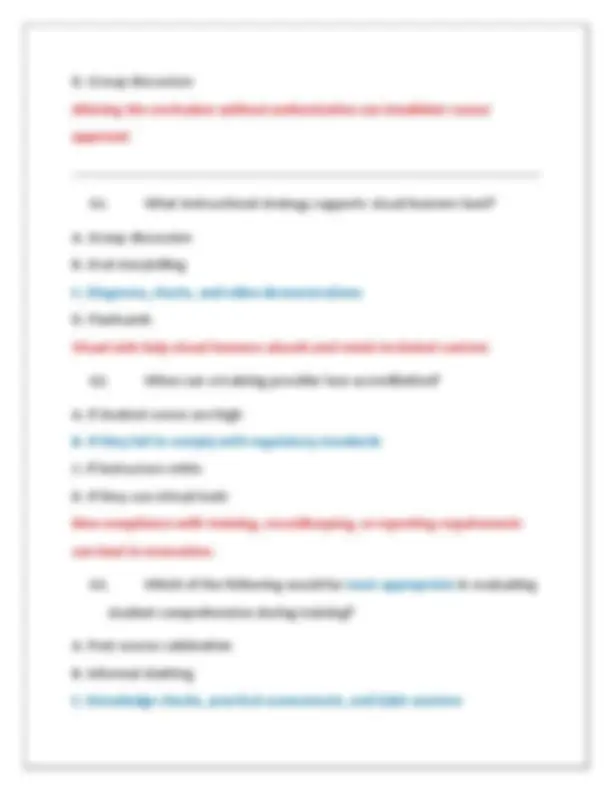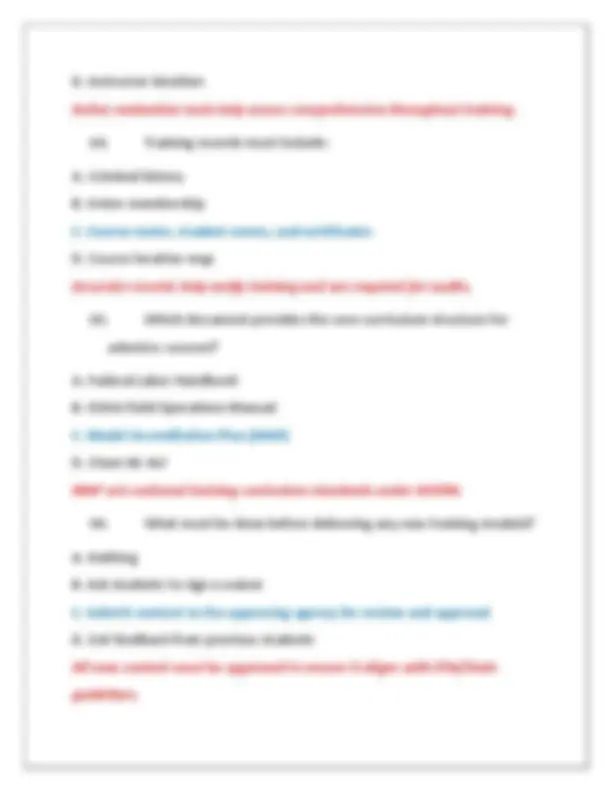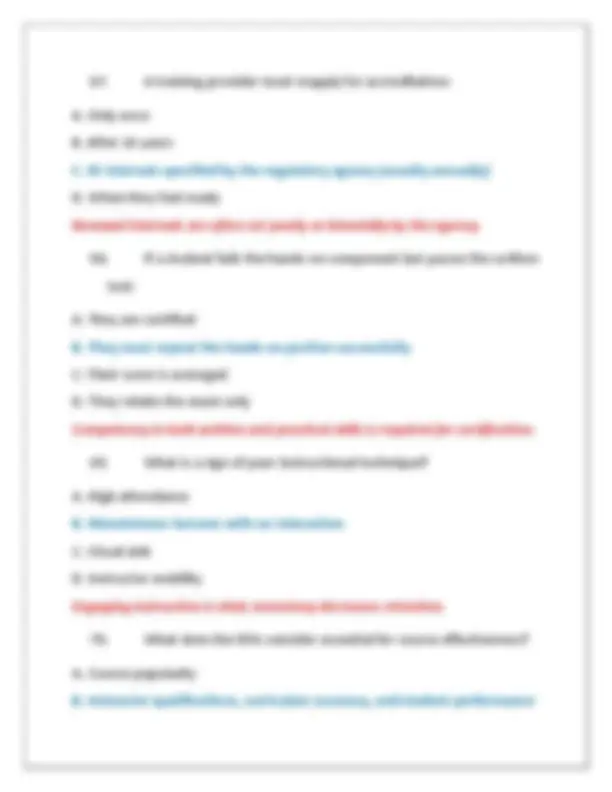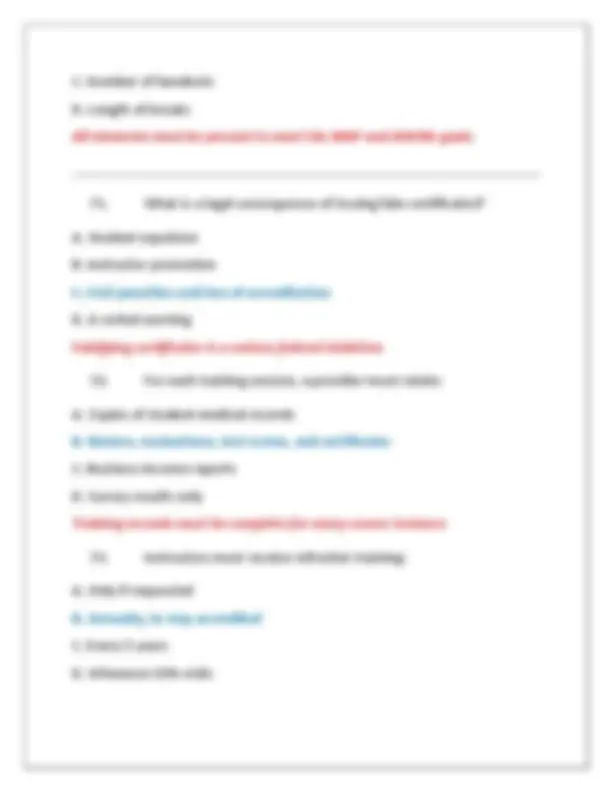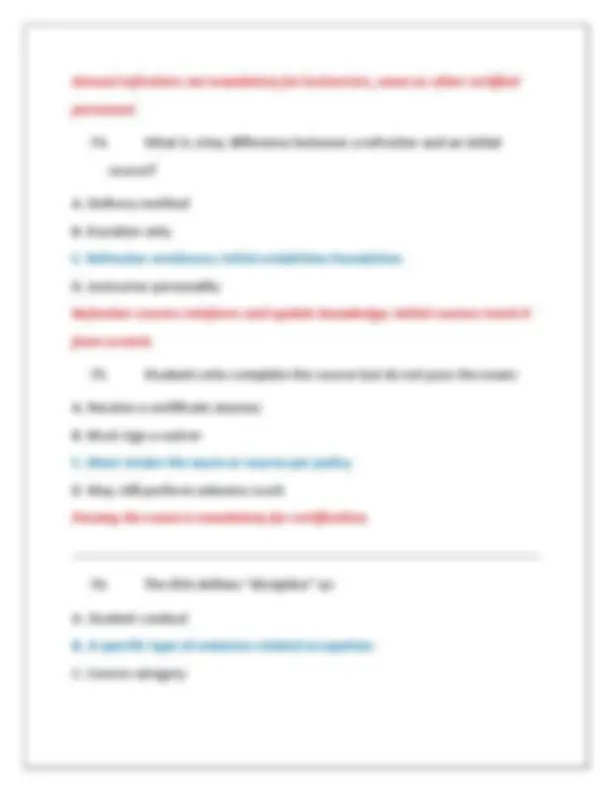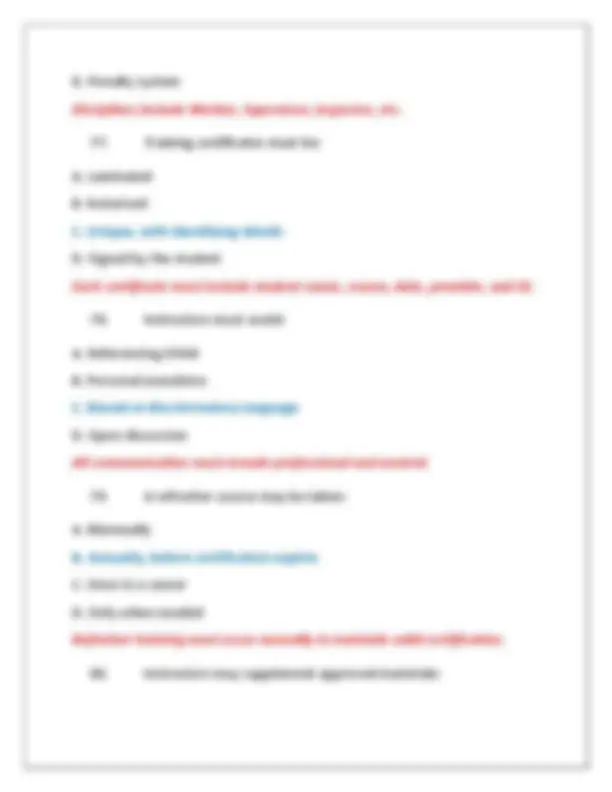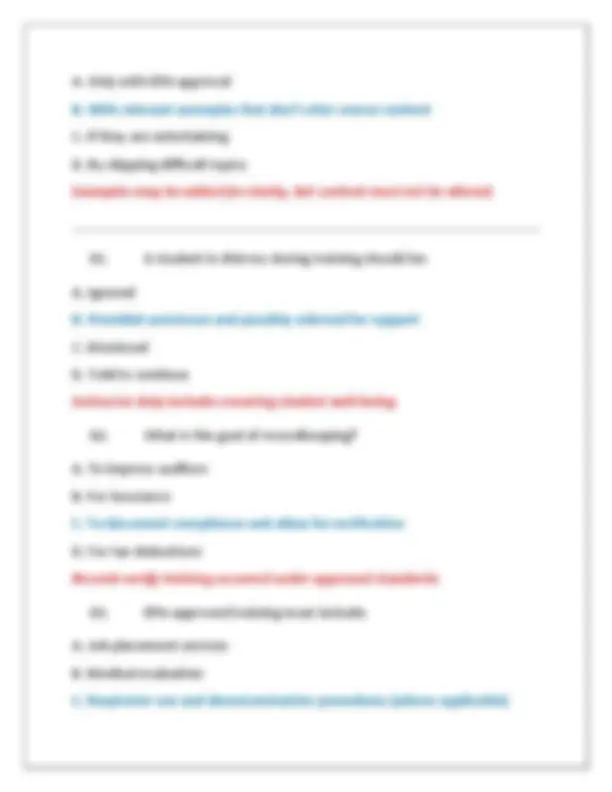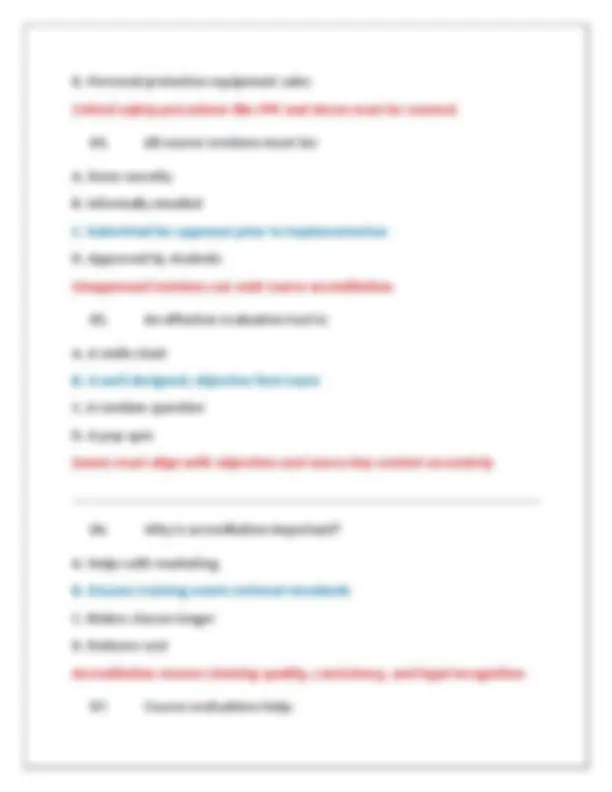Download Asbestos Training Provider/Instructor Approval Exam Practice Test 2 QUESTIONS AND CORREC and more Exams Environmental Engineering in PDF only on Docsity!
Asbestos Training Provider/Instructor
Approval Exam Practice Test 2 QUESTIONS
AND CORRECT ANSWERS (VERIFIED
ANSWERS) PLUS RATIONALES 2025 Q&A |
INSTANT DOWNLOAD PDF
- What is the primary regulatory body overseeing the approval of asbestos training providers under AHERA? A. EPA B. State Department of Environmental Protection C. OSHA D. NIOSH The EPA delegates the authority to states, but ultimately, training provider oversight is under EPA AHERA implementation, usually managed by the state DEP or designated authority.
- Which of the following is required for a course to be considered EPA- accredited? A. Course must be taught by an OSHA-authorized instructor B. Course must have a certificate of completion only C. Course must meet the Model Accreditation Plan (MAP) requirements D. Course must be under 8 hours in duration MAP outlines the curriculum, instructor qualifications, and course logistics required for EPA accreditation.
- How long must an asbestos training provider retain student attendance records? A. 1 year B. 3 years C. 5 years D. Permanently EPA guidelines require training providers to retain records for a minimum of 3 years, though longer is often recommended.
- A refresher course must be at least: A. 2 hours B. 6 hours C. 4 hours D. 8 hours According to the MAP, refresher courses must be at least 4 hours.
D. HUD
OSHA regulates worker safety and exposure in occupational settings.
- What is the main teaching challenge for adult learners? A. Lack of discipline B. Lack of relevance C. Poor reading skills D. Attendance Adults need training to be practical and applicable to their real-world experiences.
- A training provider must submit course notifications to the approving agency at least: A. 2 days before the course B. 10 days before the course C. 5 days before the course D. After the course ends Most states and EPA regions require notification at least 10 working days in advance.
- What is a critical component of an approved asbestos course exam? A. Open-book format B. Closed-book, multiple-choice with minimum passing score C. Oral questions
D. Essay only __EPA requires a closed-book exam with a specific minimum passing score, usually 70%. __
- What is the maximum class size for an asbestos worker course according to EPA MAP? A. 15 B. 30 C. 25 D. 40 To ensure safety and quality, the maximum is typically 25 students for worker training.
- Which of the following is NOT a core competency for asbestos instructors? A. Technical asbestos knowledge B. Instructional experience C. Hands-on training skills D. Project design licensure While instructors must be well-qualified, a project designer license is not required unless teaching that specific course.
- Under AHERA, how often must instructors take refresher training to stay current?
- How must the final exam be administered in an AHERA- approved training course? A. Online B. Take-home format C. In-person, proctored, closed-book D. Optional Final exams must be monitored, in-person, and closed-book for validity and compliance.
- How long must a provider keep records of student exam results? A. 6 months B. Until the next course C. 3 years D. 10 years This mirrors the record retention period for all student-related materials.
- What must be included in a course completion certificate? A. Instructor’s biography B. Meal options C. Student name, course title, dates, provider ID, and exam result D. Just the course name A certificate must document all critical elements for verification purposes.
- An instructor’s resume must demonstrate:
A. Military background B. Field experience and teaching competency C. OSHA 500 certification only D. Personal references Demonstrated asbestos-specific field experience and teaching skills are required.
- Which of the following is most important when evaluating an instructor's teaching effectiveness? A. Course fees B. Uniform color C. Student feedback and test scores D. Instructor’s age Evaluation focuses on how well students retain and apply the knowledge.
- What is a primary reason for requiring hands-on assessments in asbestos courses? A. To reduce course length B. To verify practical competency C. To comply with OSHA 1910. D. To save on testing costs Hands-on assessments ensure students can safely and correctly apply learned skills.
Proper notification must be submitted prior to the start time, often 24 hours in advance.
- If a course provider changes course content, what must be done? A. Nothing if instructor remains the same B. Submit revised materials for re-approval C. Notify students only D. Reschedule the course Any material change must be approved by the regulatory authority to maintain accreditation.
- What is the most effective technique to maintain learner engagement? A. Long lectures B. Reading slides verbatim C. Interactive activities D. Open-ended homework Interactive strategies promote learner retention and active participation.
- Instructors teaching Spanish-speaking students must: A. Translate only written tests B. Use bilingual slides only C. Be fluent or use an approved interpreter D. Rely on student translation
Clear communication is essential for safety and understanding; use qualified interpreters or bilingual instructors.
- An effective lesson plan must include: A. Student names B. Objectives, methods, and materials C. Break schedules D. Parking information A proper lesson plan outlines the structure of content delivery.
- Training providers must submit what for each course taught? A. Meal receipts B. Security deposit C. Attendance rosters and exam results D. Advertising flyers Attendance and scores are essential for auditing and student verification.
- What should be the minimum passing score for an AHERA exam? A. 50% B. 60% C. 70% D. 80% AHERA requires students to achieve at least 70% to demonstrate competency.
- To maintain instructor approval, what documentation may be periodically reviewed? A. Social media accounts B. Training history and refresher certificates C. Utility bills D. Credit report Regulators may audit credentials, certificates, and continuing education.
- What agency publishes the “Model Accreditation Plan”? A. OSHA B. HUD C. EPA D. CDC The EPA publishes and maintains the MAP, the national standard for asbestos training.
- How soon must student certificates be issued after successful course completion? A. Within 60 days B. After the course is audited C. Immediately or within a reasonable time (e.g., 1 week) D. Only upon request Timely issuance is critical for students needing proof for employment.
- If a training provider moves locations, what must they do?
A. Inform students only B. Send mass emails C. Notify the approving authority and update course files D. Wait for annual review Regulators must be notified of any administrative or logistical changes.
- Which of the following is a common deficiency during a training course audit? A. Offering refreshments B. Starting on time C. Instructor deviating from approved curriculum D. High student scores Instructors must teach the approved content; deviations require pre- approval.
- Which teaching strategy is not aligned with adult learning principles? A. Sharing work experience B. Real-life scenarios C. Passive listening for long periods D. Collaborative learning Adults learn best through active, practical, and relevant engagement.
- What best describes a formative assessment?
C. Retake the whole course D. Report the student to EPA Providers may allow supervised make-up exams in accordance with state/EPA rules.
- How often must an accredited instructor teach to retain approval? A. Once every 5 years B. Once only C. At least once every 2 years D. Monthly Infrequent instruction may lead to skill loss and requalification requirements.
- Which of the following is required in the student’s permanent training file? A. Social security card copy B. Exam score and attendance C. Bank account info D. Home internet provider Essential documentation includes proof of attendance, score, and certificate copy.
- When must training materials be updated?
A. Every 10 years B. Only for new instructors C. When regulations change D. Only if a student complains Course content must reflect current federal and state regulations.
- What defines "scope of approval" for a training provider? A. Their student demographic B. The specific disciplines and courses they are accredited to teach C. Their classroom location D. The number of handouts Scope of approval defines exactly what the provider is permitted to deliver.
- What is a major risk of allowing unqualified instructors to teach? A. Higher salary cost B. Faster course delivery C. Regulatory violations and unsafe graduates D. More creativity in teaching Unqualified instruction endangers student safety and noncompliance with law.
- What tool is most appropriate for measuring course effectiveness? A. Instructor mood B. Number of classroom breaks
A. Certify project managers B. Ensure safety and regulatory compliance in asbestos-related work C. Prepare students for civil service exams D. Teach asbestos mining safety AHERA aims to ensure that workers and professionals are competent and compliant in asbestos-related environments.
- How often should instructors review and update course content? A. Every 10 years B. Whenever regulations or industry practices change C. Only when the EPA contacts them D. Once a new textbook is published To remain compliant, course content must reflect current laws and best practices.
- What is the main function of a hands-on component in asbestos courses? A. Reduce liability B. Entertain the class C. Reinforce practical skills D. Add hours to the course Hands-on exercises build practical skills crucial for working safely with asbestos.
- Which of the following must be included in an instructor’s file for audit? A. Social security number B. Favorite teaching topic C. Resume, certifications, and evidence of qualifications D. Salary information Auditors check qualifications to ensure compliance with AHERA standards.
- How should training providers respond to changes in state asbestos laws? A. Wait for federal confirmation B. Immediately update curriculum and notify instructors C. Continue current training D. Ask students for opinions Courses must reflect both federal and state laws; immediate updates are necessary for compliance.
- A provider is required to submit course rosters: A. Only when asked B. According to regulatory deadlines, often within 10-14 days after the course C. Every fiscal year D. Along with instructor evaluations

